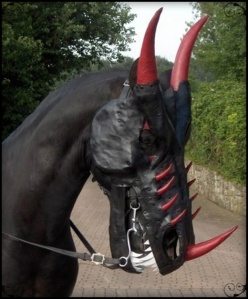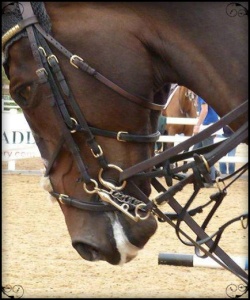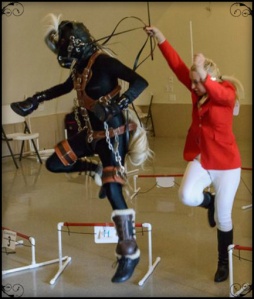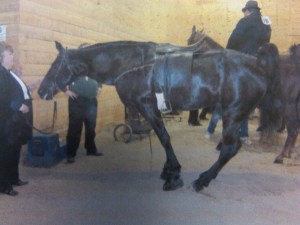 Written by: Kimberly Spiegel
Written by: Kimberly Spiegel
Reprinted with permission
This letter was originally written by Kimberly to Michael Hackenberger, the owner of the Bowmanville Zoo. In Defense of Animals (IDA) has accused the independent facility, which is located about 75 km east of Toronto, of imposing a “cruel sentence” on its only elephant, a 50-year-old female named Limba, whose existence the group describes as “[a] miserable, lonely life.”
Dear Mr. Hackenberger,
I’m glad that we spoke the other day. I think it’s really important to start a civil dialogue on these issues between animal rights activists and zoos. I only regret that I could not remember all the details of Limba’s case and the details of your zoo the day we spoke, but I have done much research since then and spent a couple days thinking of an appropriate follow-up response to our discussion.
First of all, it is sad people who support non-violence and love of animals would say hateful things to you. That is not constructive and gets us nowhere. According to Gary Francione, professor at Rutgers University: “The animal rights position is the ultimate rejection of violence. It is the ultimate affirmation of peace. I see the animal rights movement as the logical progression of the peace movement, which seeks to end conflict between humans. The animal rights movement ideally seeks to take that a step further and to end conflict between humans and nonhumans.” The root of the issue among animal rights people is that we don’t see animals as property and that they aren’t ours to do whatever we like with them, no matter how well-intentioned one might be. Your zoo is unique from other zoos because your primary focus seems to be the use of your animals in film, television, circuses, fairs, children’s parties, and other events. Indeed one might think from your long CV that your zoo is merely a front for your animal actor business. As quoted in your CV “Bowmanville Zoo is one of the largest suppliers of trained animals for the feature film and television industry…. Maintaining the largest stable of trained movie and television animals in Canada, the Bowmanville Zoo brings cutting edge operant conditioning techniques and behavioral modification to the animals under its stewardship.” Your CV lists 22 feature films (4 with elephants), 80 television movies and series (26 with elephants), and 58 commercial credits (23 with elephants).
It is no secret you use your animals for profit, and I understand that it may be what pays for the maintenance of the zoo and the animal’s food, but other reputable zoos do not do this. The point is we feel it is wrong to make animals behave in ways that can only be induced by “operant conditioning” and “behavior modification.”
Obviously, you are forcing animals to do things that they would never do in the wild. In addition, because of the cold winter months in Canada, Limba must be kept inside in a small barn alone for a very long period of time, which is very unnatural as elephants normally walk many miles a day with their family group, in a warm African climate. At her age, we do not believe she should be subject to regular long travel, cold weather, a small enclosure, or being forced to act in an unnatural way and she should be allowed to retire and enjoy the remaining years of her life in a sanctuary.

Limba promotes the MS Walk
Limba’s sad state that I referred to in my first email is that at her advanced age she is still being used for circus acts and other events. It is evident from a recent video online and the Circus Mondo website that Limba is still being made to perform in Circus Mondo. I just don’t understand this desire to train animals to make them do things that are such unnatural behaviors for them, such as mount a stand and lift her legs into the air as I saw in the video. My opinion is it is merely for profit and drawing in crowds. Yet what kind of people would want to see this sort of animal exploitation I wonder. This does not teach children about elephants or why we should care about them and protect their wild habitats. It teaches them that exploitation of animals is acceptable in our society. It makes no sense that you would even use that argument about conservation of elephants and that you donate $50,000 toward their conservation, and then use your only elephant as a circus performer.
Using animals in circuses is profoundly wrong and all around the world community attitudes are demanding that animal circuses be ended. Many countries have already banned nationwide the use of wild animals in circuses: Bolivia, Peru, Israel, Signapore, Greece, Austria, Bosnia and Herzegovina, Croatia, Hungary, Costa Rica, and Paraguay. Dozens of other nations have also enacted local bans for certain cities or districts. North America is sadly lagging behind the rest of the world in empathy. Canada has local bans on the use of animals in circuses in 27 municipal jurisdictions including Vancouver. There is an obvious trend here, more and more people are waking up to the fact that animals do not belong in circus acts and it is only a matter of time before it is banned worldwide. The world’s most successful circus, Cirque de Soleil, was started by a street performer and musician, Guy Laliberté. It made him a multi-billionaire. And what is so special about his circus? It has no captive animals, just talented, attractive, healthy, fit, strong and artistic human beings.
And from your own country as reported in the Halifax News in April last year: “The Nova Scotia Department of Natural Resources is allowing Circus Mondo to perform, but is prohibiting the performance of Limba, the circus’s Asian elephant. According to the DNR, it is inhumane to transport a lone elephant and for the second year in a row, they are not allowing Limba into the province.” Now those are people who care about her welfare and recognize that elephants belong in groups. Animal welfare specialist Dr. Paul Rees of Salford University looked at the records of 200 zoos worldwide. In 2006, 69 percent of Asian elephants and 80 percent of African elephants in the world’s zoos were still being kept in groups of four or fewer. Both British and American animal welfare groups recommend elephants are kept in larger groups of seven or more that better reflects the natural habitat in the wild. Rees said “In the wild, elephant social structure is complex and, although the average group size is around 12, they can also live in even larger extended family units. Contact with members of their own species is crucial for the animals to develop normal behaviour patterns and friendships. Small group sizes in zoos may prevent this from happening.
There is no good reason for a zoo to keep just one elephant. In an awful lot of zoos around the world elephants are unable to comply with recommendations that elephants are kept in larger groups. I am absolutely convinced this is not a good thing.” He continued to say that elephants kept in small groups can display “abnormal behaviour” such as swaying on the spot or pacing in circles that suggests the animals are unhappy. Limba is totally without contact with members of her own species. Do you think this is fair? If so I dare you to try living without any contact with your own species and then see how you feel about it. In an article published online on January 16 it stated “At the behest of CAZA, Bill Peters said the zoo is in the midst of preparing a plan to acquire “companion animals for Limba.” I’m assuming this doesn’t mean other elephants.
An article quoted you as saying when Limba was brought to the zoo there were five other elephants, and as you told me on the phone the other elephants rejected her. As someone who is so knowledgeable about elephants, I’m sure you know Asian elephant females live in matriarchial groups with other females only, so by the information of elephants that have been at your zoo, I see there is only one elephant that she could have bonded with appropriately – Lisa. As you are quoted in the article saying Limba didn’t do well in the herd, well isn’t that a possible result of mixing two elephant species together and then different genders, which all would normally be four separate groups in the wild? In addition, it is my understanding that when elephants are forced to share small spaces, they don’t always get along. San Antonio Zoo Elephant Voices co-director Dr. Joyce Poole, who has been studying elephant behavior in Africa and Asia for more than 30 years, reviewed a video of two of their elephants, Lucky and Queenie, and observed: “Lucky is being terrorized by Queenie. This kind of persistent bullying is not seen in the wild, because elephants have other activities with which to occupy themselves, and because they can remove themselves from conflict, if need be. In my

Limba is forced to give rides
opinion, the primary cause of this undesirable situation is that the elephants have too little space.” Limba might very well thrive and be able to make friends at the Elephant Sanctuary in Tennessee, without the pressure of a confined space that causes conflict among elephants. I think it is very selfish of you to not give her this opportunity to see if it even will work for her.
Your view that Limba is well-treated and well-loved, as you have stated, is a total matter of perception and requires that love is defined. To me, the definition of love is that condition in which the happiness of another being is essential to your own. It means to look out for the best interests of another and to not infringe upon its free will in any way. In this case, it would mean not exploiting animals in the entertainment industry or making them do anything that is unnatural to their normal wild animal behavior. The issue is not necessarily about abuse, although we put animals in situations that can and frequently does lead to their mistreatment which is irresponsible of us and immoral. Might does not mean right, just because we can exert power over others, does not mean we should. Animal rights also stem to larger issues. We feel control, violence, and oppression of animals is a societal ill and can only be cured by their total abolition. We equate it to abolition of slavery in the US. Abolition was only ethical once all the slaves could be free. It wasn’t enough for just the northern states to be free.
Animals just do not belong stuck in our world irrespective of how well we treat them. Humans have no business continuing to bring these creatures into a world in which they simply do not fit. I don’t doubt that Limba has accepted you and your family as her family, but what choice did she have? Elephants are social, loving creatures that live in family groups and she needed someone to love and you were her only choice, but she doesn’t belong with your family, she belongs with members of her own species. It cannot be said to be free will when there is an absence of choice.
As you know, elephants that have been forced to perform in circuses have killed people, and then they must be shot and killed themselves, such as in 1994 an elephant named Tyke killed her trainer and injured 12 people at a circus performing in Honolulu, then was shot to death (shot over 100 times). Animal behavior can change unexpectedly as these animals may eventually snap from years of stress and mistreatment and hurt people. Even if your animal is treated completely humanely, people see Limba in Circus Mondo and might think it is ok to go to other circuses such as Ringling Brothers which repeatedly abuse and seriously mistreat their elephants, so you are contributing to the perpetuation of this form of entertainment that allows animals to be abused.
I was able to obtain the history of elephants kept at your zoo online. You have had 6 elephant deaths, 5 of which were wild caught for this industry.
Asian elephants:
1) Lisa 1988, euthanized 1990 due to foot problems, age 32, 2 years at your zoo
2) Tony 1995, dead 1999 cause of death unknown???, age 27 years, 4 years at your zoo
3) Ceasar 2001, dead 2006, cause of death unown??? Age 19, 5 years at your zoo
4) Vance 1988, dead 2008, euthanized due to leg problems, age 37, 20 years at your zoo
African elephants:
1) Sheba 1984, dead 2011, euthanized for unknown reasons???, age 36, 8-10 years at your zoo
2) Angus 1986, dead 2006, cause of death unknown???, age 27, 20 years at your zoo

Limba is seen here promoting the Grand Cru Culinary Wine Festival in Toronto, by handing out flowers
I’m sure you are aware of the study of elephant lifespans from the University of Guelph published in Science in 2008 which found that wild African elephant females lived to be a median age of 56 and that Asian elephants could live to be at least 42 years (working timber elephant data, no data on wild elephants). The study also found that zoo elephants of both African and Asian species tended to die at much younger ages than either wild African elephants or working Asian elephants. The researchers said the median lifespan for elephants that died in European zoos between 1960 and 2005 was only 17 years for the African species and 19 years for the Asian animals. Stress, lack of exercise and obesity were thought to be largely responsible for the shorter lifespan of the zoo elephants. Median lifespan is 29.5 for your deceased Asian elephants and 32 for the Africans, considerably shorter than wild elephants.
Limba, age 49, arrived 1989, has outlived all your other elephants which is hopefully a sign of her being well cared for. Yet I wonder about the unlisted causes of death of 4 of your 6 elephants.
You also told me on the phone you did not believe the Elephant Sanctuary in Tennessee would be a better place for her because they have had a death of a keeper and because of tuberculosis that killed some of their elephants. Your elephant Tony was from the same Hawthorne herd as the others who died of TB at the Elephant Sanctuary and I wonder if he died of that also? I don’t know how long you have been director, but in 1988 Tarra was relocated from the Bowmanville Zoo to the Elephant Sanctuary in Tennessee and she is still alive and well. As for the death of the keeper by Winkie, it was known that that elephant had behavioral problems and it was certainly an unfortunate incident. But your zoo is responsible for a lion who knocked over and broke four ribs of Gitanjali Kolanad, so these things can happen when working with animals, their behavior is totally unpredictable and anyone who has ever worked with animals knows that.
Limba is likely at greater health risks from standing on hard surfaces in cold weather with little movement for long periods of time at your zoo than she ever would be at the Elephant Sanctuary. From a Seattle Times article “The Times did a first-of-its-kind analysis of 390 elephant fatalities at accredited U.S. zoos for the past 50 years. It found that most of the elephants died from injury or disease linked to conditions of their captivity, from chronic foot problems caused by standing on hard surfaces to musculoskeletal disorders from inactivity caused by being penned or chained for days and weeks at a time.” It appears two of your own elephants died from foot and leg problems, and the other 4 unreported causes of death possibly fit into one of these categories. This is truly a disgrace that most elephants die because of being in captivity. How is sentencing them to die in a prison essentially considered caring for their well being?
The median age for the Asian elephants living at the Elephant Sanctuary in Tennessee is 47 and the median age of those who have passed is 48, whereas at your zoo the median age at death of Asian elephants is 29.5, a 20 year difference which is quite significant. I believe the Elephant Sanctuary in Tennessee would be a better habitat for Limba because she would have much more space to roam around. Your whole zoo is only 42 acres, the Elephant Sanctuary of Tennessee is 2,700 acres. Limba would obviously have much more space for exercise, more than she has had since being stolen from the wild. Elephants in the wild are used to traveling many miles a day. I think she deserves a chance to really be an elephant and to try to get integrated with the other group of female Asian elephants at the Tennessee Elephant Sanctuary.
David Hancock who was director of Woodland Park Zoo from 1976 to 1984 said, “Elephants don’t thrive in zoos. We didn’t understand elephants very well in the 1970s or ’80s. But there is overwhelming scientific evidence today that shows the

Many people are disturbed to see elephants performing unnatural and undignified acts
harmful impact of captivity.” Animals are often prevented from doing most of the things that are natural and important to them, like running, foraging, choosing a partner, and being with others of their own kind. Zoos teach people that it is acceptable to interfere with animals and keep them locked up in captivity, where they are bored, cramped, lonely, deprived of all control over their lives, and far from their natural homes.
You mentioned that zoos are important for education and conservation purposes. I would argue that seeing an animal in captivity as it exhibits behaviors of stress and boredom while living in a sterile environment is much less educational than, for example, watching a National Geographic video of animals filmed in the wild. In addition, conservation efforts aren’t always successful. Benjamin Beck, former associate director of biological programs at the National Zoo in Washington, D.C., found that in the last century, only 16 of 145 reintroduction programs worldwide ever actually restored any animal populations to the wild. Of those, most were carried out by government agencies, not zoos. Most zoo animals released in the wild don’t survive. This is because zoos don’t provide the right environment for a successful captive breeding project. The animals would need to live in habitats resembling their natural ones, especially in terms of climate and fauna. Zoos spend huge amounts of money on their breeding programs, even though breeding animals in captivity isn’t the best way to help in conservation.
It is at least 50 times more expensive to maintain elephants in zoos than to protect equivalent numbers of elephants in the wild. Using the money for conservation programs in the wild – by creating more protected reserves for instance – will not only allow the animals to live in their natural habitat, it also helps balance whole ecosystems. Zoos that do breed animals do so because it gains them a lot of publicity and attract huge amounts of people. David Hancock estimates that less than 3 percent of the budget of accredited zoos in the AZA goes toward conservation efforts. At the same time, they point to the billions of dollars spent every year on hi-tech exhibits and marketing efforts to lure visitors. Zoos main interest is always to make money and baby animals are their most powerful marketing tool. And even if there was a huge asset to saving endangered species from zoos, your zoo in particular does not contribute to this – so how can you defend it specifically on those grounds? Elephants in particular are not being bred for reintroduction to the wild – that will never happen because of the high infant mortality rate.
I believe you also stated Limba had higher cortisol levels while children were riding her, but cortisol is released in response to stress – so was that just a blatant lie or did I misunderstand? In case I misheard you and you actually said she had lower cortisol levels while carrying children around, it is still not a scientifically valid reason to keep her without comparable data of what her cortisol levels would be living amongst her family or other elephants that might act as a surrogate family in a more appropriate natural environment. I haven’t seen the data myself to even know the truth and I’m not inclined to just take your word for it. Right now you are her surrogate family, but she doesn’t belong in the human world. You have been quoted as saying “I’ve never made any secret of the fact if an elephant behaves inappropriately I will discipline it. It’s like spanking a child.” Can you discipline from a place of love? This is a controversial issue even among human parents who might physically or verbally discipline their children. This is quite a concern for me because the only reason you would need to discipline her is if she is trying to just be an elephant and not performing how you want her to perform. She is not a child, she is an elephant, and treating her as anything but is nonsensical and shows the lack of respect and understanding you truly have for non-human animals. You wouldn’t treat your sons like elephants would you?

Animals used in circuses are unwilling participants in a show that jeopardizes their health and mental well-being and the lives of human spectators and performers. Circuses force animals to perform tricks that have nothing to do with how these magnificent creatures behave in the wild.
You also mentioned on the phone if people have a problem with how Limba is treated that they should take it up with OSPCA or CAZA and some animal rights people in Canada have stated there are serious problems with both organizations and that they couldn’t be relied upon. It was stated that they would call the OSPCA if they were at all credible and cared about something other than money, and that they are a dysfunctional organization lacking in transparency. Some evidence that they may not be reputable is that they are a registered charity yet will not release their salary amounts to the public. Another has said that CAZA is a club that is there to create an illusion of oversight and keep people without vested interests at arm’s length and they do not enforce even minimum standards and simply overlook anyone that fails to meet them.
People who speak out for animals such as myself, do so from the perspective that animals are equal to humans in their ability to feel, to suffer, and have equal rights to freedom and the exercising of their free will. When we see that an animal is no longer able to have freedom or at least to have its unnatural state diminished, we speak out, out of compassion. I see the sacredness in all life, and I would never desire to exert power and control over another living thing. But you do. What does that say about you? Power is always veiled by ideas that are thought to be good. A whole ideology is then built around such an idea, making it a worldview that appears as striving for what is good, while in essence, you are trying to control life – both in yourself and in others. FEEL the energy of wanting to control things. Is that a loving energy? Often, that energy poses as love, as the good and the true, but power always conceals itself in this way so it is easier for people to accept. Power does not show its face openly; power seduces through thought.
I became a biologist to protect wild places for animals, it is an absolute irony to me when zoos say they are working to promote conservation all the while keeping animals out of the wild. I can maybe see the benefit of captive breeding programs to reintroduce wildlife populations in decline, but since so few have been successful it is potentially just a waste of money that could be diverted to protecting other species in the wild that have better chances. Extinctions will be inevitable. The idea of just having animals in captivity to “educate” people about them is a total fallacy.
I did not develop my love of nature and wildlife from zoos. I developed it by actually spending time in nature, by connecting with it. In my own backyard I was lucky enough to live in a rural area and have this opportunity to observe birds, frogs, salamanders, mammals, and turtles. I went canoeing, hiking, and camping as a child. I developed such a profound love for nature that I have dedicated my life to protecting it in its most natural state. I understand not all children have these opportunities when they live in urban areas, but bringing children to zoos perpetuates the myth that this promotes conservation when all it promotes is the fact that we can exert our power over “lesser beings.” They are not lesser, they are equal. I can see the value in having unreleasable, injured native animals captive for educational purposes, but not exotic animals. It is morally wrong and unjustifiable to take perfectly healthy animals from their mothers at a young age from the wild, which inevitably damages their psyche for life. Then especially to turn them into circus performers, that is abhorrent.
What is really disturbing is that wild elephants are still being captured for zoos, 6 elephant calves were just captured from the wild in Zimbabwe and may be sold to Chinese zoos. Four have already been sent to Chinese zoos recently and one has since died. This is unacceptable that this continues! Zoos do not promote conservation, they promote the exploitation and the view that an animal is property and we should be allowed to do what we want with them. They are not property, they are not somethings, they are someones. What we really want to see is an end to exotic animals in captivity and used for performing in circuses and film. There are not natural for animals and are f orced into these situations by their owners which they are totally at the mercy of because animals are defined as property. Certain animals that require large amounts of space such as elephants should not be kept in zoos if the proper environment can never be provided for. There is enough evidence that elephants do not thrive in the usually too small zoo enclosures.
orced into these situations by their owners which they are totally at the mercy of because animals are defined as property. Certain animals that require large amounts of space such as elephants should not be kept in zoos if the proper environment can never be provided for. There is enough evidence that elephants do not thrive in the usually too small zoo enclosures.
As we discussed, Africa has its problems with extreme poverty that leads people to poach elephants for ivory to feed their families. It is a sad state of the world when rich countries like the US and Canada spend millions of dollars on many forms of mindless entertainment and many things they don’t need instead of helping those in need in poorer countries when it might actually stop poaching. I think we can agree that there are many things about our society that need to change, but sending Limba to a sanctuary is one thing that you can actually do to make it just a little bit better, for her and for the message you will be sending to the world that she is loved and deserves to retire and enjoy for a little while a real elephant’s life. I don’t think I know more than you, but sometimes seeing things through another’s eyes is beneficial.
 Written by: Heather Clemenceau
Written by: Heather Clemenceau
 Horse lovers response to the issue of horse slaughter was enough to make a cowboy’s head spin when hundreds of horse lovers “mobbed” the Facebook page to say “neigh” to horsemeat. I stopped counting at 300 pics, which galloped past our goal of 100 photos. I’m sure we left more than a few clueless onlookers gaping in the background on Ferguson’s Facebook page. Be sure to visit the page and “like” our photos. And please remember to thank Craig Ferguson (and like his Facebook page) for indulging our Facebook Flashmob!
Horse lovers response to the issue of horse slaughter was enough to make a cowboy’s head spin when hundreds of horse lovers “mobbed” the Facebook page to say “neigh” to horsemeat. I stopped counting at 300 pics, which galloped past our goal of 100 photos. I’m sure we left more than a few clueless onlookers gaping in the background on Ferguson’s Facebook page. Be sure to visit the page and “like” our photos. And please remember to thank Craig Ferguson (and like his Facebook page) for indulging our Facebook Flashmob!




























































